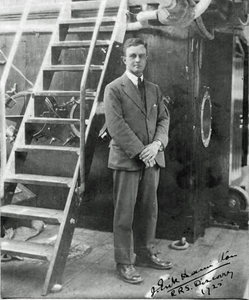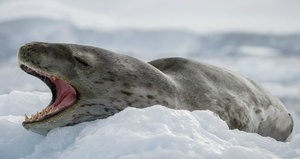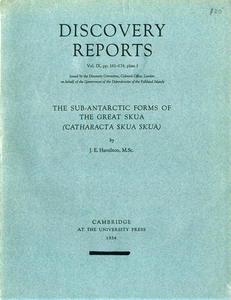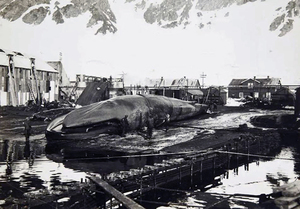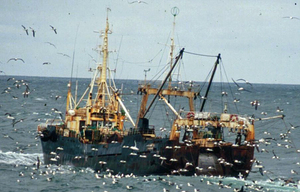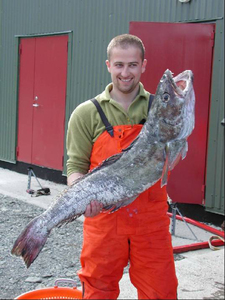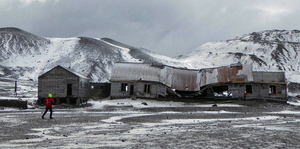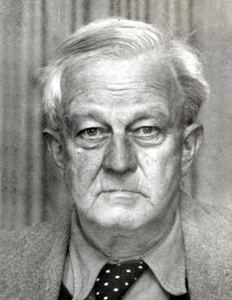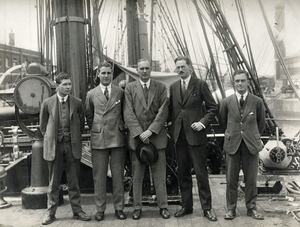HAMILTON, JAMES ERIK (Ham, Shag, Hamilton)
1891 - 1957 from England
government naturalist, was born in Liverpool on 26 May 1891 to The Reverend James Hamilton (1859-1935; a Church of Scotland minister) and Barbara Roberton (1862-1936) After graduating from Liverpool University in 1913 Hamilton spent two summers working in Ireland investigating the biological problems associated with the whaling station which was located at Belmullet Bay, Co Mayo. In 1914 he was awarded a M.Sc. for his work in oceanography. He joined the Territorial Army at the beginning of World War I, but was discharged because of his flat feet. Hamilton became an assistant demonstrator at Kings College, London and subsequently at The Queen's University, Belfast.
In 1916 Hamilton joined the Royal Army Medical Corps as a bacteriologist, and in 1919 he moved to the Falkland Islands upon his appointment as magistrate for West Falkland Island and the South Shetlands. He was appointed government naturalist in January 1921. Hamilton made the first attempt to assess the numbers of Fur Seals in the Falkland Islands in 1919. His report gives a highly graphic account of his activities, but it is remarkably imprecise about seal populations. The lack of accuracy of Hamilton's seal counts was to have serious consequences in later years, when successive administrations fixed the level of sealing quotas for Sea Lions and Elephant Seals too high. Fur Seal numbers were estimated to be 5,500 in total and insufficient to support an industry - particularly as substantial poaching by Chilean ships of Fur Seals was still occurring.
Hamilton recommended that a 3-inch naval gun be placed on Elephant Jason Island to deter poachers. He urged strong protection measures for the Fur Seal, but added that the numbers of Sea Lions were such that they 'are a field for industrial development.' The Seal Fishery (Consolidation) Ordinance 1921 was introduced. Seal fishery officers were appointed in 1922 and armed officers were placed at major rookeries during the breeding season. Fur sealing was prohibited.
HMCS Afterglow was purchased to assist with protection of the rookeries. There were worries in the Colony that the cost of this protection could not be met from the revenues of the sealing industry.
Hamilton was appointed Falkland Islands Dependencies administrator in 1921 and was resident on Deception Island (part of the South Shetland Islands group) during several whaling seasons. He oversaw the whaling operations of a number of floating factories and one shore station. During his first whaling season (1920/1921) the shore line in the vicinity of the whaling station subsided as the result of volcanic activity, and 'the water in the harbour boiled removing the paint from the hulls of vessels moored there'.
In 1922 Hamilton warned about the increasing rarity of the Striated Caracara (Johnny Rook) (Phalcoboenus australis) as the result of the Government policy of culling birds of prey and the payment of a bounty for their beaks. In April 1923 Governor MIDDLETON wrote to the Secretary of State expressing concern about the diminishing numbers of Fur Seals in the Falkland Islands. Hamilton visited Elephant Jason Island, Bird Island and Volunteer Rocks from October 1922 to March 1923, and his report showed that although the exact number of Fur Seals could not be stated with complete accuracy, nevertheless the numbers were far fewer than had been indicated in earlier reports.
Hamilton believed that the presence of large numbers of Sea Lions on or near the hauling or breeding places of the Fur Seal was most undesirable and that steps should be taken to remove them. There should be no difficulty in doing this if the Sea Lions were driven to the edge of the rocks and shot there or in the water.
He concluded that Fur Seal numbers were now so low that the Islands would be unable to support the costs of a protection scheme within a reasonable time: 'At £3 per skin an annual yield of 1,496 skins would be necessary and this implies a herd of over 30,000 Fur Seals, and highly polygamous at that'.
During his period of secondment to the Discovery Expeditions Hamilton was engaged on several research projects, and he published a number of papers in various scientific journals. His most important work concerned the Southern Sea Lion (Otaria byronia) and the Leopard Seal (Hydrunga leptonyx) (see: Discovery Reports 1939). He was awarded a doctorate for his work on Sea Lions. His period of service with the Discovery Expeditions was not wholly successful or happy. He had a number of strong disagreements with the Scientific Director - Stanley KEMP.
The Minutes of the Discovery Committee record that:
Dr. Kemp expressed the view that Hamilton's inability to work harmoniously with his colleagues rendered it difficult to utilise his services in any senior capacity commensurate with his salary; and the Committee were inclined to the opinion that the best course would be for Mr Hamilton to revert to Colonial employment on the occurrence of a suitable vacancy.
Kemp opposed Hamilton's application for the post of Senior Scientist in 1928.
In 1939 the Falkland Islands Government investigated the possibility that trout from Tierra del Fuego could be successfully introduced to the Islands. Hamilton actively supported the introduction of trout citing the example of what had been done in Tierra del Fuego in 1935, where a successful introduction of trout had been made. In 1940 small quantities of the fertilised ova of Brown Trout (Salmo trutta), American Brook Trout (Salvelinus fontinalis) and Rainbow Trout (Oncorhynchus mykiss) were imported from Chile and incubated by Hamilton in a small hatchery at Moody Brook. The Brook and Rainbow Trout ova died, but the Brown Trout survived and were introduced into the Moody Brook, and possibly to the Murrell River.
During the late 1930s Hamilton became increasingly concerned with the preservation of the remaining stocks of whales. He continued throughout World War II to send annual reports of the activities of the whalers on South Georgia. He warned on 30 September 1942 that:
The Fin Whale is the important (commercially) species - 1,189 were taken, 585 males and 604 females, but only 471 of the combined sexes were adults, that is 39·6%. Sixty one or 27·3% of the adult females were pregnant. The decrease in the percentage of adults has been in progress for some years ... the continuing reduction is a strong indication of similar decreases in stocks ... the herd is becoming thinned out to such an extent that adult females have less chance in becoming pregnant and therefore replenishing the stock. On the whole one cannot take an optimistic view of the future of this species.
The Colonial Office was alarmed at Hamilton's despatch and it commented: 'The Government Naturalist's report shows a very significant and disturbing position as to the stocks of Fin Whales'. As a result of Hamilton's reports the Colonial Office commissioned CF Hickling to prepare a brief summary of the situation as a starting point for the debate about the future of Southern Ocean whaling. His report was prepared with the assistance of Hamilton and contained a stark warning:
It will indeed be a world tragedy if the whale stocks of the south have suffered the same fate as those of the north; and those of us who have been warning of the danger of over-fishing during the inter-war years will get no satisfaction at all from the fulfilment of our warnings ... We can only hope that this coming season will give results which will belie those of last season ... Why won't the business people heed the warnings of the scientist until it is too late?
Some British government officials did not take Hamilton or Hickling's warning seriously. A conference held at the Ministry of Agriculture Fisheries and Food on 1 December 1942 considered the matter of the postwar whaling industry. Despite Hamilton's warnings, and his considerable local knowledge, the conference concluded: 'It was considered desirable that the whaling industry should be got to work as soon as possible on the conclusion of the war'.
With the support of Governor CLIFFORD, Hamilton began to investigate the prospects for fishing in the Falkland Islands. Clifford commented:
I tried to get this [fishing research] done with Dr. H [Hamilton] in charge of a three-year experiment. Boats were obtained, and the services of a professional fisherman secured. But the Discovery Committee turned down the scheme. It was great mistake for which the Colony will pay.
In 1944 Hamilton wrote a long memorandum about the prospects for a future fishing industry in the Falkland Islands. It was the first local attempt to consider the economic potential of fishing - albeit coastal rather than offshore fishing. Hamilton acknowledged that very little was known about inshore fisheries outside the work of the Discovery Investigations. He proposed a five-year research project to be funded by a grant (possibly from the Discovery Committee). The objects of the research were to be to increase the supply of fish locally, and to examine export potential. Hamilton wished to 'develop a fish eating habit' amongst the Islands population. He proposed, initially, to use the Penguin (a 15·8m former government steam launch) and he stated that 'the real reason for the shortage [of fish] is the lack of capital to purchase adequate equipment and the absence of any fishing tradition'.
Hamilton recommended the investigation of the potential of Mullet, 'Sprat Herring', Rock Cod, Mussels and Krill; Mullet could be taken with seine nets. Hamilton recalled that Vernet exported 80 tonnes of salted fish from Port Louis in the early nineteenth century, and that since then fishing had been a spasmodic affair - or a pastime amusement. Capital costs were calculated to be £4,900 and the recurrent costs would be £6,300 annually:
There are no fishermen in the Falkland Islands, and an essential part of the proposed scheme will be the training of apprentices in the care and construction of gear and the art of fishing. It is hoped that in this way a skilled nucleus may be created capable not only of carrying on an industry which may be established by the research but also of founding that tradition upon which all permanent fisheries depend.
The proposal was forwarded to the Colonial Office in 1946. The project was opposed by some people in the Falkland Islands on grounds of 'non-essentiality'; On 17 June 1948 Governor Clifford telegraphed the Secretary of State that 'fishing ... would never take the place of mutton'. The Colonial Office approved a revised scheme costing £9,100 and funding was made available from the Colonial Development and Welfare Fund. A suitable 9·2m fishing vessel was found but, after protracted negotiations, Governor Clifford had second thoughts, the purchase was not completed and the scheme was abandoned. This illustrates the difficulties of development in the colony, post-World War II, due to the lack of finance within the Falkland Islands and the unwillingness of the British Government to undertake substantial investment in the Colony.
In 1931 Hamilton married Rose Purdie. During World War II Hamilton was greatly involved in the political and social life of the Falkland Islands. At various times he served as registrar-general, police magistrate and a temporary member of LegCo.
The post of government naturalist was abolished in 1949, as an economy measure, and Hamilton retired on pension on 8 November 1949. After his retirement from government service Hamilton continued to make outspoken comments about the level of over-fishing of the remaining whale stocks. He also continued to live in the Falkland Islands, where 'he carried on with his collecting and zoological work.' He enjoyed camping out in remote spots to observe the wild life, a favourite destination being Cape Dolphin. His time spent studying the cormorant colony there earned him the local nickname 'Shag Hamilton'.
Hamilton was assisted in his work as the government naturalist by Arthur George BENNETT, who acted as assistant government naturalist, from 1922 until 1938. Their relationship was sometimes a little strained. During a visit to Deception Island Hamilton (not known for his tidiness) insisted on dissecting a seal in Bennett's office (who was acting as postmaster and magistrate at the time) and the mess and stench were such that Bennett was forced to find other accommodation for the remainder of the whaling season. The two men collected much rare cetacean material which was subsequently deposited in the Natural History Museum in London. The specimens were accompanied by very detailed notes and data.
In 1933 Hamilton and Bennett successfully prevented the introduction of Patagonian Fox (Dusicyon griseus griseus) to New Island and Carcass Island. Jason Hansen had made the request to introduce the fox in order to 'control the Upland Geese, to kill rats and rabbits and for the production of fur skins.' Hamilton and Bennett advised the Governor that: 'the introduction of any form of new life is a danger in any country, and too often proves the cure is worse than the disease'.
He was awarded the Polar Medal (Bronze) in 1944 and was appointed to the Imperial Service Order in 1948. Hamilton died suddenly on 15 April 1957 and is buried in Stanley cemetery. He enjoyed 'the rough conditions of life' during his expeditions, and he was often found in the more remote parts of the Falkland Islands. 'He enjoyed the company of sealers and whalers, among whom he had many friends'.
External links
References
Stephen Palmer; 'James Erik Hamilton – The Falkland Islands Government Naturalist.'; Falkland Islands Journal; 2006
John Hamilton; The Southern Sea Lion, Otaria byronia (De Blainville) ; Discovery Investigations Report 1934
John Hamilton; The Sub-Antarctic Forms of the Great Skua (Catharacta skua skua); Discovery Investigations Report 1934
John Hamilton; The Leopard Seal Hydrurga leptonyx (De Blainville); Discovery Investigations Report; 1939
John Hamilton; A Rare Porpoise of the South Atlantic, Phocaena dioptrica (Lahille, 1912); Discovery Investigations Report; 1941
Comments
Revisions
May 2019 Photographs added
September 2019 Additional photograph added; five references added; external link added
October 2019 Additional photograph added
November 2019 Five additional photographs added
December 2019 One additional photograph added
September 2020 One additional photograph added; three additional internal links added
July 2022 Text updated
April 2023 Text updated
August 2025 Two images changed
